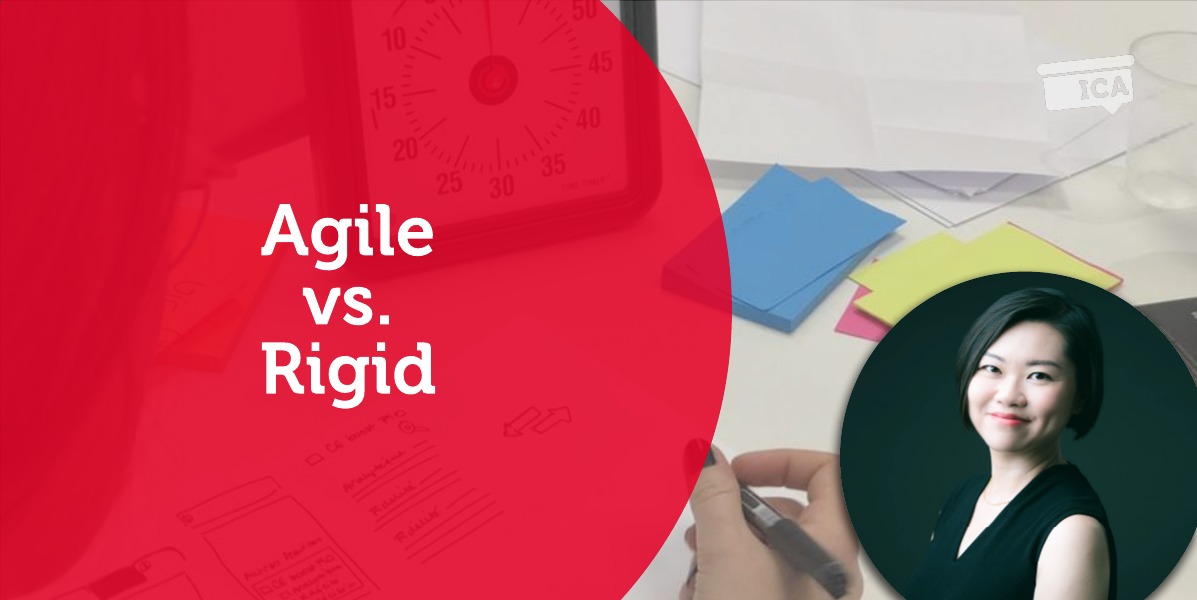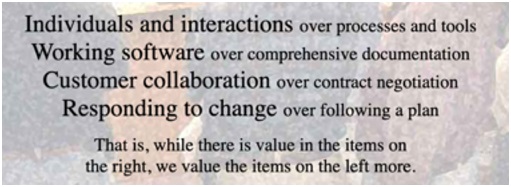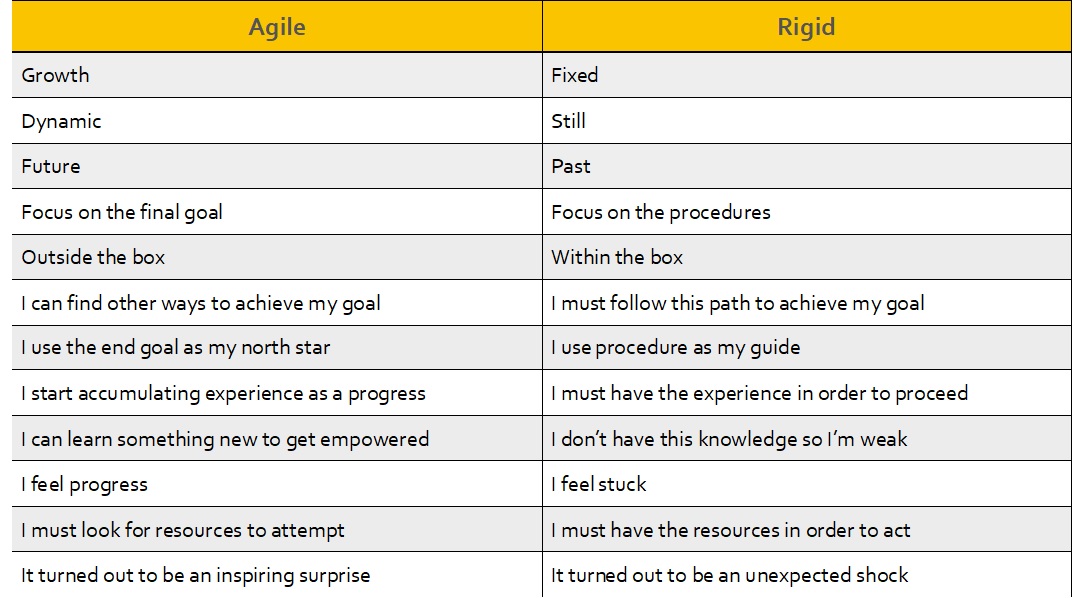
A Coaching Power Tool Created by Margot Ling
(Performance & Empowerment Coach, HONG KONG)
Agile is an attitude, not a technique with boundaries. An attitude has no boundaries, so we wouldn’t ask “can I use Agile here” but rather “how would I act in an Agile way” or “how Agile can we be, here?- Quote by Dr. Alistair Cockburn, co-author of the Agile Manifesto, 2007.
Inspiration by Life Stories
Before getting into the details on how Agile vs Rigid can be a power tool for coaching, here are some stories I heard which granted me inspiration to approach the Agile way of life.
An old friend of mine who has been working in companies in senior managerial roles for almost 20 years decided to resign due to consistently having tremendous over-time work. As a mother of two primary school children, she decided to find another job that could grant her more flexible hours. In the beginning, she was very confident that within 3 months’ time, she could land in a new job with less demanding hours. However, after more than a year, she has not found a suitable new job. During our discussion, I heard a lot of justification for her current situation, which I totally empathized with. For instance, her experience was outdated and the “younger generation” worked differently, or, she has insufficient contacts to start her own business, etc. What I heard from her was that there must a certain path in order to get into a certain career.
As an entrepreneur and advocate on Agility, some questions naturally came to my mind: “If you don’t have these contacts, what can you do to build these contacts?”, “What can you do to modify your way of working such as taking a course or something to learn that quickly?” I sense the energy of Rigidity, focusing on the known processes and original plans in her mind. What might be missing is integrating her plan with the world and business environment. Certainly, when I asked her these questions openly she gave me an interesting look, “Oh, I haven’t thought about it that way!”. An ah-ha moment.
Another story about an Asian woman in her mid-forties. Anyone from a traditional headhunting company might see her resume as “jumpy” and “inconsistent”, though there were notable ground-breaking achievements she brought in for her employers. Over her career years, she had lived in 3 cities, with 8 full-time jobs, some of which with Fortune 500 companies. Unfortunately, she had experienced corporate structural lay-off 3 times, and worse of all, she also had 3 failed digital media start-ups and several short-lived business ventures. Based on the society’s known success formula, this is certainly not a gold standard or straight forward path people wish to follow. She had gone through times of exhaustion and feeling lost. She kept questioning why all her plans were in vain.
Fortunately, she discovered the concepts of Agility and growth mindset. With a shift to an Agile approach, she tried to look beyond and integrate her potentials with the world, to look into space where she is needed in the market. She realized that all these years her path was moving fluidly with the ever-evolving media and technology industry. She was a pioneer in something new, facilitating and closing deals, then moving on to new ventures. Instead of holding tightly to perceived failures, she used her experience to create something new in the market, to try to launch it fast, adjust the model, and keep learning. She is also using an Agile approach in her company structure to minimize administrative effort. Now, she can confidently call herself an entrepreneur, happily running her consultancy business and looking into expansion. She has convincing stories to tell and advice to share, thanks to her tough times. One thing she keeps in mind – stay curious and keep learning.
That was my own story.
Agility is becoming very important in modern life. In the past, we tended to embrace structure and track record in our working methods. However, as technology continues to progress so fast beyond boundaries, these methods can hardly keep up. Artificially intelligent algorithms, rapidly changing workforce needs, and overseas competitors with cross-border scalability create huge challenges for local businesses. After all these years, my takeaway is: we empower our survival by becoming Agile – to be able to embrace changes, think swiftly in an out of the box mode, strategically leverage on some unseen resources, keep learning and most importantly, put these thoughts into actions!
We cannot underestimate the negative impacts of Rigidity. This does not imply that we need to work without a plan or structure. Instead, the definition of Rigidity is cleaving too closely to a pre-known pathway, a known prerequisite to get from A to B. There are more pathways than only 1, and the shape of the path can be straight, curly or frizzy…
What is Agile and Rigid?
Are there only standard or “default” ways to solve problems or to make things happen? Can there be other means and perspectives for a quick shift? Of course, the answer is yes, and Agility helps us uncover them. Very often, we follow too strictly the systems we are familiar with for our present and future living. However, the world is ever-changing; how can we keep up with it? One of the emerging approaches is to be Agile, instead of being Rigid.
Literally, based on Oxford Learners Dictionaries, the word Agile is an adjective meaning “able to move quickly and easily”, “able to think quickly and in an intelligent way”, “used to describe a way of managing projects in which work is divided into a series of short tasks, with frequent pauses to review the work and adapt the plans”, and “a way of working in which the time and place of work and the roles that people carry out can all be changed according to need, and the focus is on the goals to be achieved, rather than the exact methods used”.
Many new management concepts have been developed in recent years, including several approaches to Agility, particularly in the technology industry. One well-known summary is the Agile Manifesto. It gives a useful foundation for understanding Agility. Essentially, we should understand that it is a set of values, principles, and approaches to help decision making and problem-solving, not a fixed method. It’s 4 core values are:

So, what does that imply for personal development in general?
Elaborating on these 4 engineering values in a generic life scope, we can see that there is a heavier weight on people (individuals & interactions), external help (working software), partnerships (customer collaboration) and willingness to adjust (responding to change). In life, we often focus on the known prerequisites we have learned. We often have a sense of what our life should be based on the main pathways, leading us to feel that there is only one way to succeed or only one way to be happy. However, we may have overlooked the resourceful people around us. Human beings are living and dynamic. We can learn from each other. We may find new inspiration and resources just by interacting with individuals or reading a book, learning new things and trying them out.
In summary, here is a list demonstrating the differences in the values and characteristics:

Being Agile does not mean a lack of structure, rather that we factor in less obvious resources or learning and embrace opportunities to ‘try things out’. Being Agile also means that we need to set a bigger framework with the desired outcome. Often, we call it a mission. If something is not working, we can adjust and try something another way. We know when to stop insisting after we have persisted beyond the optimal state.
Agile vs Rigid in Coaching Application
The International Coach Federation (ICF) defines coaching as partnering with clients in a thought-provoking and creative process that inspires them to maximize their personal and professional potential. Applying the Agile vs Rigid power tool to this, the coach embraces the spirit of being agile in the whole coaching process. The coach evolves with the client and facilitates the client to move from A to B, led by the client’s goals, exploration, and discoveries to actions. The coach works according to the needs and goals of the client instead of working on a fixed method.
When coaching, the Agile coach needs to be fully present, actively listen, and detect if the client has been holding back from progressing due to Rigidity. Very often a client’s intense focus on the known prerequisites to solve a problem or to move forward might not be the only answer. The coach can then use power questioning to explore, discover and create awareness of Agile vs Rigid, to shift and expand the client’s perspectives.
Questions for shifting from Rigid to Agile:
Transforming thoughts into action is also a crucial part of the Agile approach. Agility entails the concept of “movement”. Designing actions, managing progress and accountability play an important role, so the coach needs to facilitate that process during the session after the perceptive has been successfully shifted.
Reflection
References (Hyperlinks)
Oxford Learners Dictionaries
The International Coach Federation (ICF) defines coaching
If Agility had not been there, I would not be able to flex my brain and move out from what I do, but to do something new. In a way, I would use another more easy-to-understand term “entrepreneurial” spirit. Look at what resource you have, what you will need to grow and learn more. Then do it and see how it is like. Modify the model and upgrade it. As long as the ultimate mission is still there, you are on the right track! Quote from an entrepreneur, 2019.